Teaching students how to play by ear is overlooked by many teachers, but these inspirational stories will show you the benefits for both student and teacher.
Let me tell you a story. It’s about how I saved hours of work every week. It’s also about how my students (particularly my teens and pre-teens) are SO engaged in their lessons. And all I did was make one change. That change? Teaching students to play by ear.
Table Of Contents:
Kristin has only ever wanted to play pieces she knows and likes. And over the years her tastes have epically changed. We started on anything Disney, briefly moved to musicals, then Billie Eilish.
If I ever presented her with a piece that wasn’t something she knew or liked, I’d get *the look*
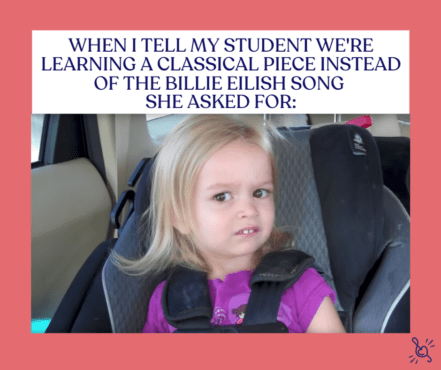
And when I say her tastes have changed, I mean on a weekly basis. For example, she once declared that her favorite song in the whole wide world is Let It Go and it would be AMAZING to play it on the piano. We had two weeks of working on it, loving playing it, and she was doing a great job. In the third lesson, she announced that she hated Frozen and never wanted to hear songs from it ever again. She gave me a long list of reasons why, and told me that it would be ‘cruel’ to ask her to carry on with it. (Yes, she’s also quite dramatic!)
I have spent hours finding arrangments of songs she’s asked to learn that we then work on for two weeks before she refuses to play them again because she’s “over” them.
Recently, her tastes have changed yet again to obscure bands and singers I’ve never heard of (because they’re YouTube and TikTok singers). Turns out no one else has heard of them either, because no transcriptions of their songs exist anywhere. But every week I’m asked the same question, “When am I going to start learning [name of obscure song]” She will.not.let.up.
I used to spend hours trying and failing to find these songs.
Until I made the change.
Sam loves pop songs. Always has done. Anything that’s in the Top 40 or trending (I think that’s what the kids say these days?!) she’s all over. She loves playing any arrangement of a pop song I can find for her.
Sam’s problem? She’s slow. And this is absolutely by her own admission.
She tells me she’s the slowest of her friends at walking to class. The slowest to finish her lunch, to copy down words from the board, to get dressed for PE. She likes to take her time.
Being slow in her piano lessons frustrates Sam. She can read the notes on the page with no problem. She knows all the notes on the piano no problem. But connecting the two and working out what to play and when is a slow process. As her teacher, I don’t mind the speed. I’m happy to work on sections as many times as she needs to get the speed up.
But Sam gets frustrated.
“Things never sound right because I play them so slowly,” she sighs nearly every lesson.
I used to spend countless hours trying to find and create activities and exercises to help her speed up certain songs.
Until I made the change.
Mike is a worrier. He always wants everything to be perfect, and if it’s not he worries.
Last year he moved into the first big exam year at school. His level of worry and stress went up even more.
He told me that piano was keeping him going, and he’d play the piano to break up revision sessions and he was so thankful for that.
Mike’s favourite band released a new album and he was so excited to think he’d be able to play the songs on the piano. He saw that as a fun project alongside stressful studying.
But as I said, Mike is a worrier. When presented with the arrangement of the first song I saw the panic in his eyes.
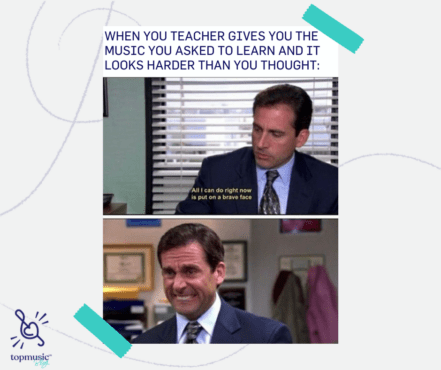
“Look at that line. I’m never gonna be able to play that. Oh gosh, look at the rhythm in the right hand there, that’s gonna be too hard. I really like this song, but I’m worried I’m not gonna be able to play it.”
I used to spend so much time searching for different arrangements of the same song, then re-arranging to try to make it Mike-friendly.
Until I made the change.
As we all know, teaching involves more than just the time in the lessons. You put in extra time sourcing material, doing admin work, planning, etc etc.
But as my studio filled up (with students recommending me to their friends and family as the “cool teacher who lets you learn songs you like”) this particular extra work became overwhelming.
I was having to use my weekends to search, source, arrange, and rearrange music for my growing list of students.
I was having to turn down making plans with friends and family because I had extra work to do to cater to my students.
But (and I’m aware this is silly) it was when I missed the final of The Great British Bake Off because I was still on my laptop rearranging a song that I thought,
“Something has to change. I can’t keep adding all of these extra hours of work into my week. There’s got to be an answer.”
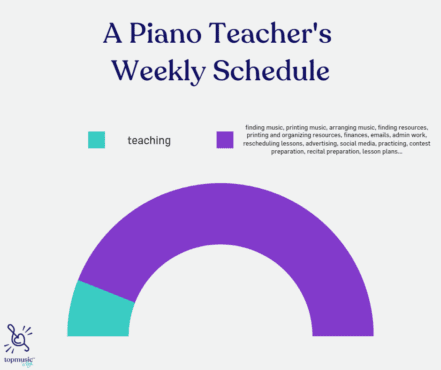
I’d always heard people talk about playing by ear, but when it came to teaching my students how to do it, I’d always passed it by. It didn’t seem the “proper” way.
It was only when I had a cancellation and I was sitting playing the piano to myself that I had the realization.
I play by ear all.the.time.
I hear a song on my Spotify recommendations and get the melody stuck in my head. I’ll sit down at the piano and figure out how to play it. If I can’t work out the chords, I’ll look them up on a chord chart. Then I have fun playing a song that I like, messing around with the left-hand patterns until I find something I think sounds good.
“Why on earth do I not teach my students to do this?!” I asked myself out loud.
They would love this skill!
If they hear a song they like, instead of me spending hours trying to find the sheet music for it online (and quite possibly failing) we can instead spend the time in their lesson listening to the song and figuring out how to play it.
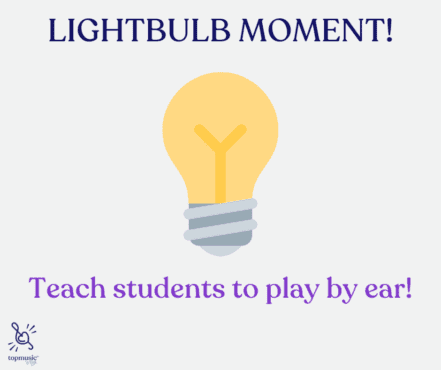
My mind started racing. There are so many benefits to teaching students how to play by ear:
“You know that McKenna Grace song you love and I couldn’t find anywhere?”
“Yeah?!”
“We’re going to learn how to play it!”
“Amazing! Where’s the music?”
I pressed play on the YouTube video. “Here it is.”
Ever since we started working together on figuring out how to play this song by ear, Kristin has been SO determined to get it right.
We’ve been using the chord chart, following the chord symbols for her left hand, and using the lyrics as a melody reminder, and she is loving the process.
This week marks our 5th lesson (we’ve passed the three-lesson mark!) of working on this song, and in every lesson, she announces how much fun she’s having.
She’s even played it to her friends, telling them it’s a “work in process” because she’s not quite happy with her left hand yet. They were all amazed, which made her feel super cool.
Playing by ear success!
Related: Improve Piano Ear Playing Skills with this One Challenge
I wasn’t planning on teaching Sam to play by ear, but I am so happy I did.
Sam has lessons online, and she saw the music I had on my piano from the previous student.
“That’s one of my favourite songs!” she exclaimed.
On the spur of the moment, I asked, “Do you want to see if you can pick up how to play it just by listening to me play it?”
I played the first phrase of the melody and she played it back almost note-perfect. After picking my jaw up off the floor I said, “Well, that was amazing!”
Sam beamed. “I could hear it being played as I was playing it so it just worked. And I could play it the speed it should be ’cause I wasn’t thinking about loads of things!”
We worked on the chord progression, keeping it simple with just a held chord every four beats.
As soon as she answered the call for her next lesson she proceeded to play the piece with both hands at the perfect speed.
“You’ve remembered ALL that and got the speed up?!” I exclaimed
Sam beamed.
Playing by ear success!
“Turn the sheet over,” I instructed as Mike battled with a particularly tricky rhythm.
He did as he was told, with a confused look on his face.
I pulled the song up on Spotify and skipped to the chorus (aka trickiest.rhythm.ever)
“Close your eyes and listen.”
Again, Mike did as he was told.
I paused the song.
“Clap the rhythm of the chorus.”
He obliged, clapping the rhythm spot on and mouthing the words.
“Play that rhythm, alternating between C and G.”
He played it and the realization hit.
“Is that what I’ve been trying to play?! That’s so not as hard as it looks!”
We continued listening to the song in sections and playing it back. He already half-knew the notes from the sheet music, but playing the song back after listening to it first turned Mike into the most confident version of him I’d ever seen!
We’re still working on the album project, bypassing the sheet music and figuring out how to play by ear. I’ve not heard any worries from Mike for months now!
Playing by ear success!
Okay, so it’s a bit of a dramatic statement (but we’re all allowed to be a bit OTT from time to time!)
Teaching my students how to play by ear has definitely had an impact on my life.
I’m no longer spending hours every weekend finding new music for fickle students who then change their minds.
I’m no longer taking hours out of my weekend creating activities and exercises for specific songs.
I no longer need to spend hours re-arranging music to make it easier for students to understand.
You know what I’m doing with that time? Resting and recharging with my family. (And catching up on the Great British Bake Off Final!)
There’s one thing that’s really helped me when it comes to teaching students how to play by ear. Because even though it was a skill I possessed, I’d never gone about teaching it before.
Pop Song Solutions has been incredibly useful for me. Whether I’ve been teaching the same songs that Tim uses, or I’ve seen methods I can incorporate in teaching different songs by ear, I have learned so much.
And honestly, I don’t think my students would be having as much fun as they are if it wasn’t for Pop Song Solution.
Pop Song Solutions is a member-exclusive series available to Lite, Studio, and Evolution members.
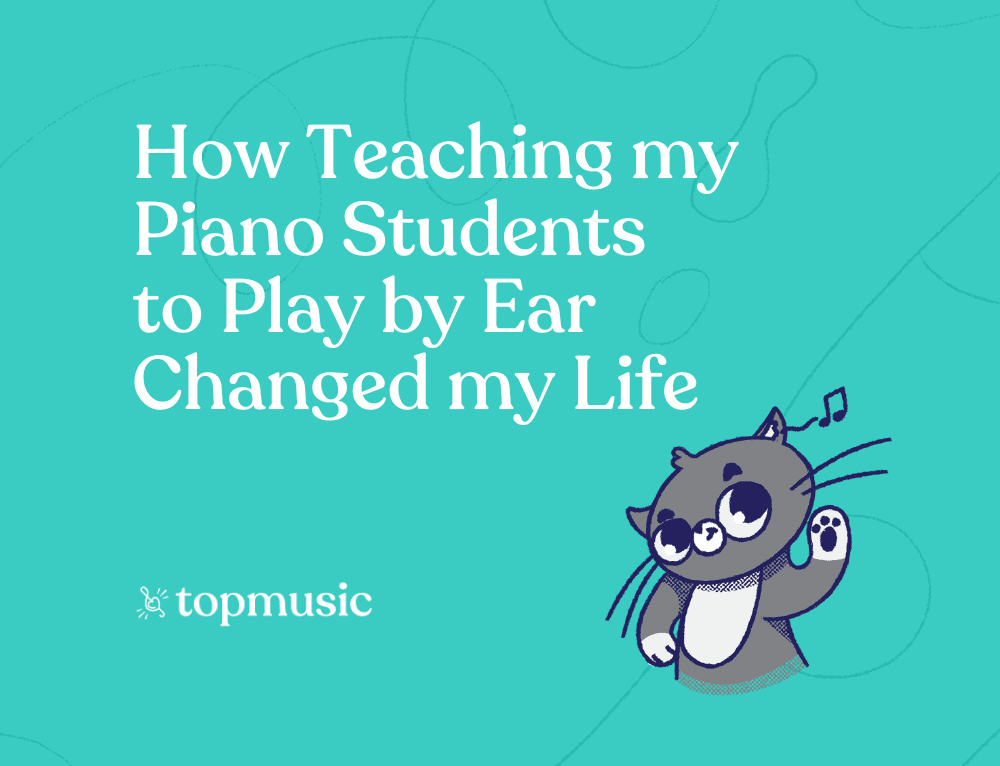
Ian says:
Fantastic article! Thanks so much for explaining this. Soooo many teachers seem to be afraid of this and spin their wheels trying to “customize” their sheet music instead of teaching their students to be…musicians! 🙂 I am behind this trend 100%